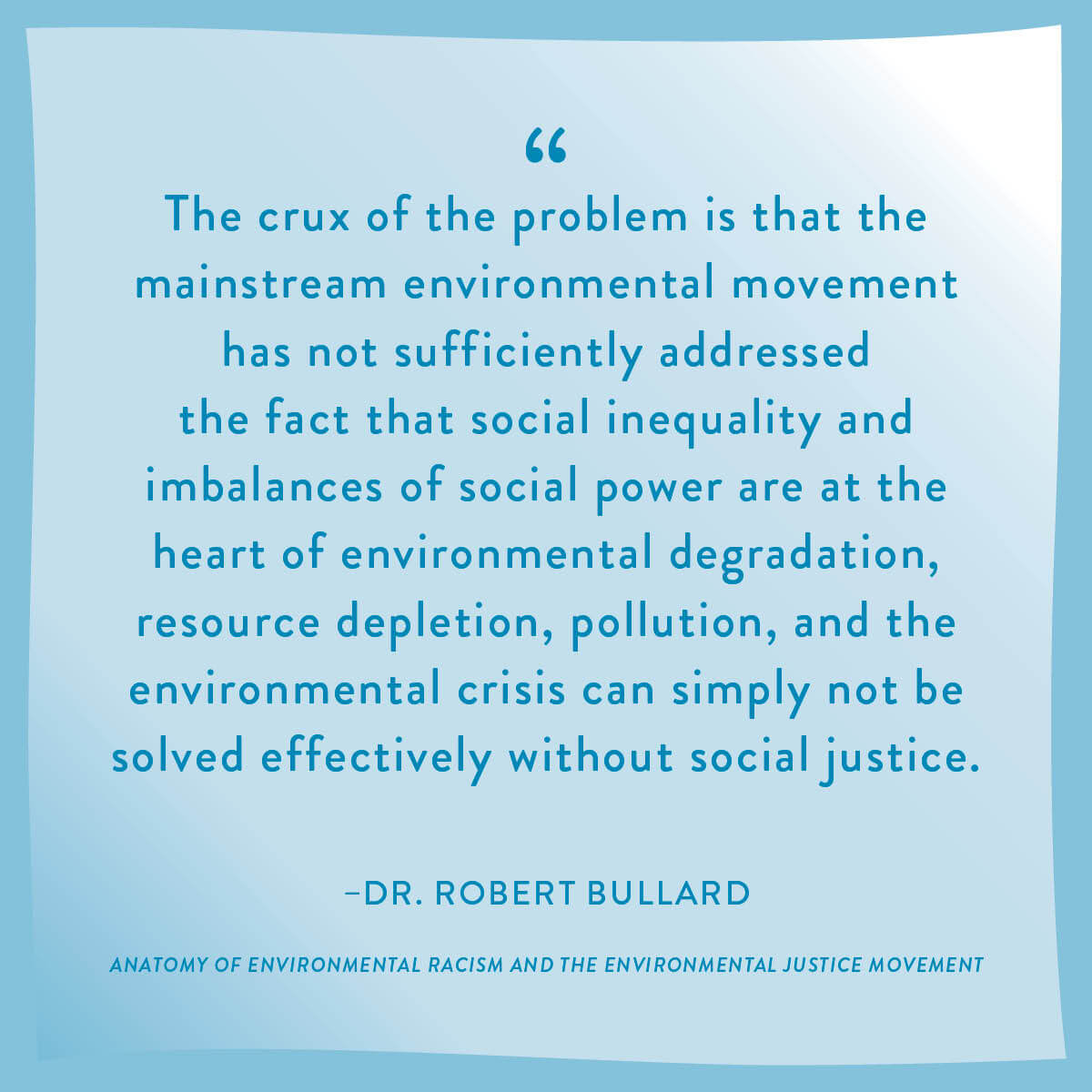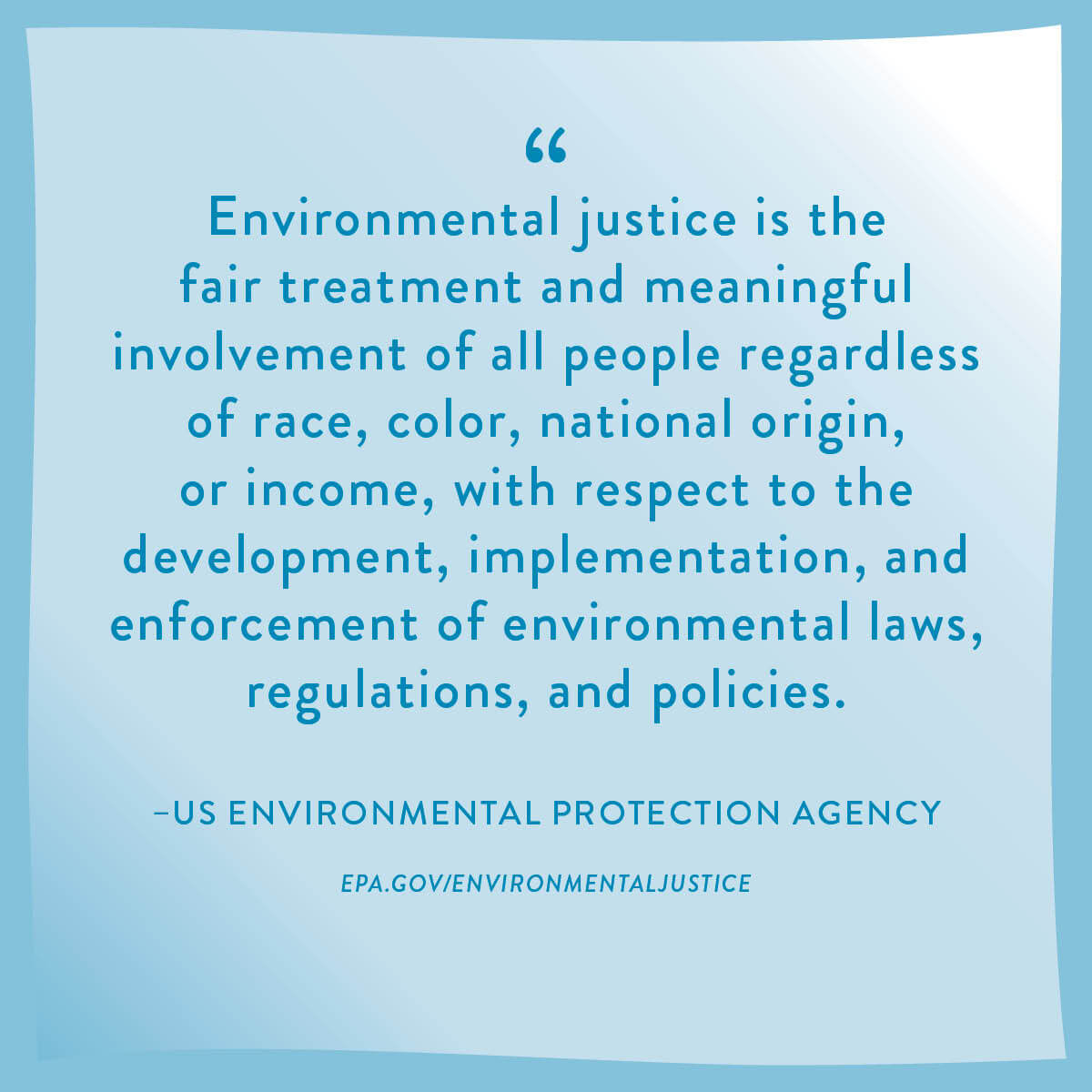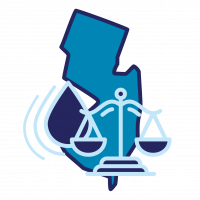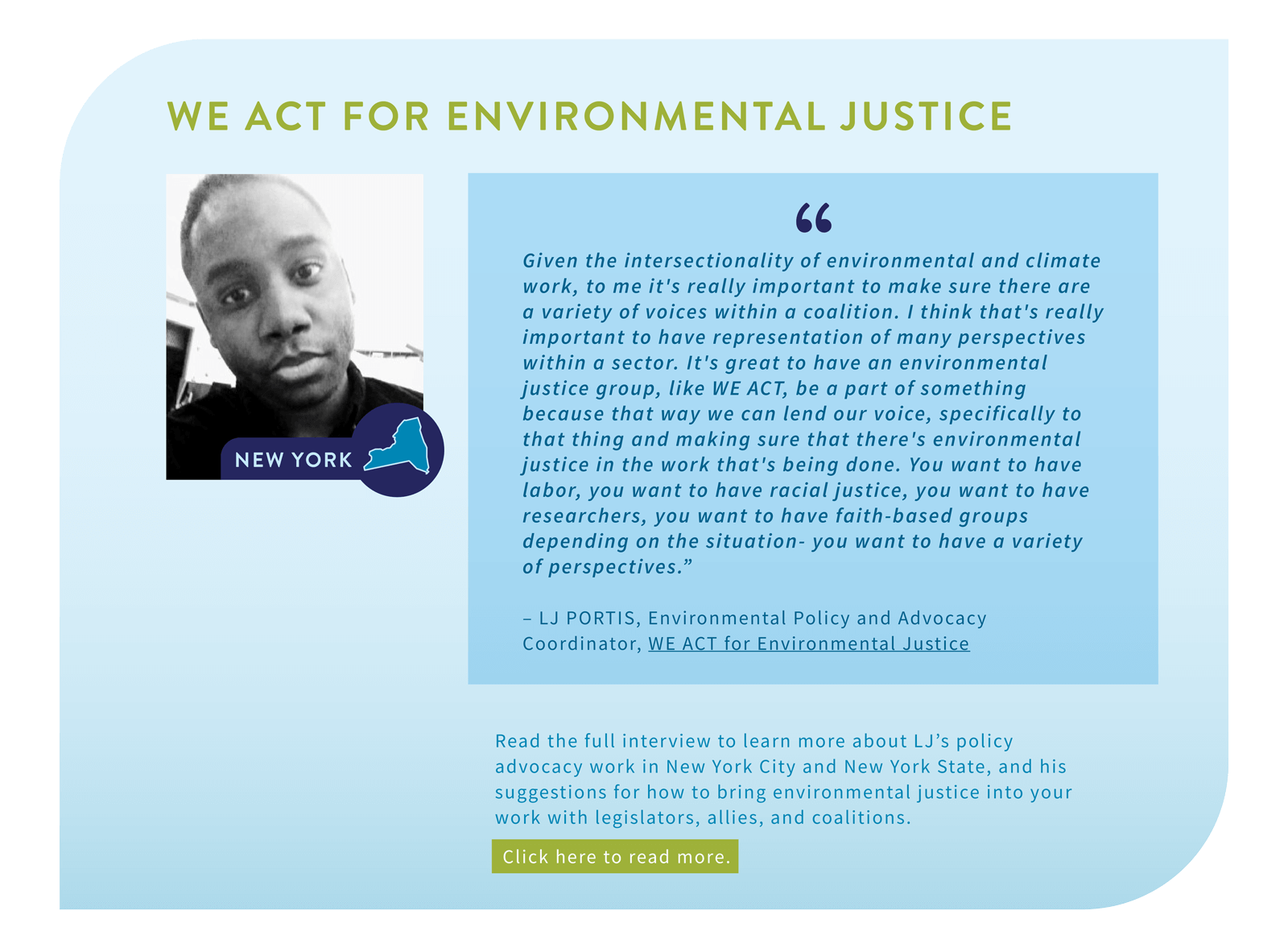State Action on Environmental Justice
What’s the Issue?
The environmental justice movement uses the ideals, tactics, and strategies of the civil rights movement, while also drawing from feminist, Indigenous, antiwar and antinuclear movements, and the mainstream environmental movement to address the problems of environmental racism and the systemic link between environmental degradation and its unequal impacts on working class and communities of color. The term environmental racism describes how the lives of Black, Indigenous, and people of color (BIPOC) are disproportionately impacted through heightened exposure to environmental and health risks, both in their neighborhoods and their workplaces. Robert Bullard, a founder of the environmental justice (EJ) movement, describes these communities as “environmental sacrifice zones” where industry and the state site undesirable, often toxic plants and processing sites in the neighborhoods of poor communities of color, causing cumulative and pervasive impacts to the soil, air, and water.
Protests in Warren County, North Carolina sparked the environmental justice movement in the early 1980s. Black residents opposed the siting of a sanitary landfill near their community that contained soil with high levels of polychlorinated biphenyl (PCB). The landmark study by the United Church of Christ Commission on Racial Justice in 1987, Toxic Wastes and Race in the United States, identified race as an important factor across a slew of environmentally dangerous exposures, even when holding economic class constant. While African Americans comprised only 20 percent of the population of eight states in the south, 75 percent of hazardous commercial waste landfills existed in Black majority communities in those states. The study helped formalize the reality that greater environmental health risks are borne by people of color and low-income people.
In 1991, the First National People of Color Environmental Leadership Summit convened in Washington, D.C. The event, sponsored by the United Church of Christ Commission, brought together over 1,000 community organizers from across all 50 states as well as Puerto Rico, Mexico, Chile, and the Marshall Islands. This group of delegates drafted and adopted the 17 Principles of Environmental Justice, which continues to serve as a guiding framework for the grassroots EJ movement.
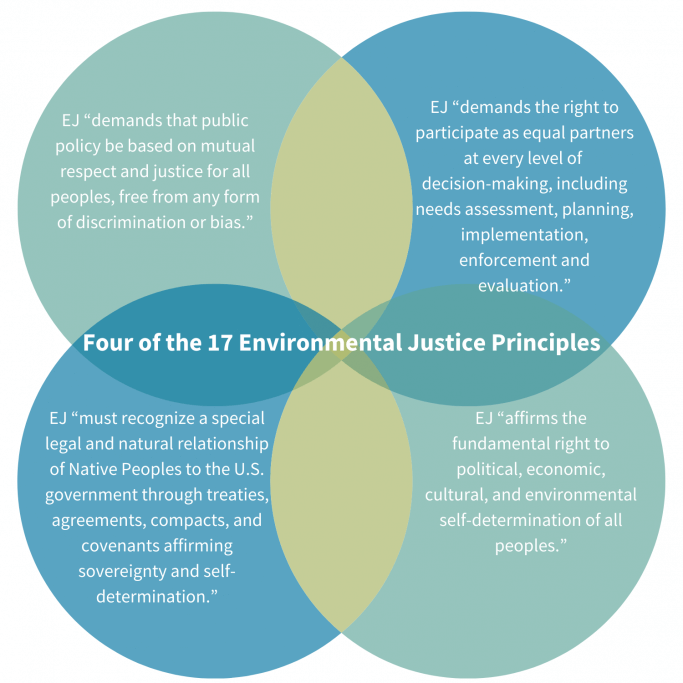 Federal Action on Environmental Justice
Federal Action on Environmental Justice
The environmental justice movement has relied on direct action, protest, and community organizing strategies, while also engaging within the regulatory and judicial systems across all levels of government. President Clinton’s Executive Order 12898 and subsequent federal environmental justice (EJ) policies and programs have faced significant challenges in implementation. Some factors include scientific uncertainty, the social complexity of EJ issues, lack of clear policy guidance, and weak regulatory enforcement. Under the Biden Administration, renewed focus on federal responsiveness to EJ issues can be seen in the “Justice40” initiative, which aims to provide 40% of certain Federal investments to disadvantaged communities. The White House Environmental Justice Advisory Council’s (WHEJAC) final recommendations for Justice40 include ensuring “safe drinking water by replacing all lead water pipes in frontline communities across America by 2030.” Other water-related recommendations of the WHEJAC include the creation of a permanent federal low-income water and sewer bill assistance program, testing and replacement of lead water pipe infrastructure in EJ communities, investment in flood mitigation and climate resilience infrastructure, and ensuring every home has a wastewater system and indoor plumbing.
Water and Environmental Justice
What does environmental justice have to do with water? As the Covid-19 pandemic shows, water access and affordability are crucial for public health- and the consequences of environmental pollution are dire. Water shutoff moratoriums during the early months of the pandemic reduced the likelihood of infection and death. The enforcement of water policies and regulations are not evenly distributed- NRDC found that Safe Drinking Water Act Violations are more likely to occur in communities of color, low-income communities, and communities with fewer housing and transportation options. The history of redlining and discriminatory land-use planning means that lead contamination in drinking water is frequently more common in communities of color than in predominantly white communities. Well maintained and functioning infrastructure is essential to clean and safe water access. When we talk about equitable water infrastructure investment, a key component is ensuring that funds are “Distributed in a way that supports the communities that are most at-risk for environmental harm and have historically lacked investment, chiefly low-income communities and communities of color.”
Environmental justice principles may be embedded within a range of state policies, but for the purposes of the State Policy Hub, we focus on policies that explicitly address environmental justice. EJ-specific policies often focus on the permitting process for polluting facilities, expanding public participation, defining “environmental justice community,” and establishing mechanisms for accountability and corrective action.
Examples of State Policy
- New Jersey: After several iterations of Executive Orders established EJ guidance and advisory councils, a landmark EJ law (S 232) became law in September 2020. Notably, it gives the Department of Environmental Protection the authority to deny permits if an environmental justice analysis determines a new facility will have a disproportionately negative impact on overburdened communities. Explore the Deep Dive to learn more.
New Jersey’s EJ Policy Milestones
- 1998
- 2004
- 2009
- 2018
- 2020
- 2021
-
1998
NJ DEP Commissioner Shinn created an Environmental Equity Task Force through Administrative order.
-
2004
Governor James McGreevey signed Executive Order No. 96
Established initial EJ framework for all executive branch departments, agencies, boards, commissions related to environmental quality and public health to follow.
Created an advisory multi-agency Environmental Justice Task Force spearheaded by DEP and DHSS.
-
2009
Governor Corzine signed Executive Order No. 131
Directed that programs should be reviewed to “meet the needs of persons living in low-income communities and communities of color; and address disproportionate exposure to environmental hazards.”
-
2018
Governor Philip Murphy signed Executive Order No. 23
Directed DEP to lead development of guidance for state agencies to consider EJ within 6 months.
-
2020
New Jersey Environmental Justice Law (S 232) signed.
Defines overburdened community
Requires EJ impact statement for permit applicants
Considers cumulative impacts when approving/denying a permit
-
2021
DEP Commissioner LaTourette issued an Administrative Order to meet legislative intent of EJ law as DEP develops regulations.
- Oregon’s EJ law (SB 420), passed in 2007, established an Environmental Justice Task Force which developed best practices for natural resources agencies. Recent legislation (HB 4077 & HB 3293) and a visionary resolution expanded the scope of SB 420 to apply to all agencies and specifically directs agencies to provide funding to local organizations and governments for public participation and community engagement efforts related to water projects in disproportionately impacted communities.
- California’s legislature has passed several EJ-related bills over the past two decades. This includes SB 1000 in 2016, which updated the General Plan Guidelines for cities and counties to include integration of environmental justice considerations in disadvantaged communities, providing local-level planning parameters for environmental justice concerns. California’s Department of Justice is settling with the City of Huntington Park to facilitate compliance with the law after multiple attempts to address the noncompliance of the city’s General Plan. AB 1628 revised the state’s definition of environmental justice in 2019.
- Federal-State partnerships: On September 10, 2021, the CalEPA and US EPA (Region 9) pledged to a five-year memorandum of understanding to jointly address environmental justice activities, the first–of–its–kind partnership for regulators at the state and federal level to address compliance concerns in overburdened communities.
- New York‘s cumulative impact law mirrors New Jersey’s, and the state’s efforts through the Climate Leadership and Community Protection Act (2019) include robust public participation, including around the development of disadvantaged communities criteria.
Additional Resources
- Environmental Justice State By State, a law library of EJ laws, policies, mapping tools, and definitions, created via a collaboration of American University, Environmental Justice Clinic at Vermont Law & Graduate School, Lone Star Legal Aid, Taproot Earth, Tishman Environment and Design Center at The New School, UC College of the Law, San Francisco, University of Texas School of Law, Austin Environmental Clinic
- Tishman Environment and Design Center’s Defining Environmental Justice Communities for Policy includes an interactive map and a chart showcasing environmental justice definitions at state and local levels.
- Pro Bono Clearinghouse, by the Environmental Law Institute, connects attorneys and communities to solve pressing environmental problems.
- Watered Down Justice, NRDC, Coming Clean, and Environmental Justice Health Alliance (2019)
- Examines nationwide violations of the Safe Drinking Water Act (SDWA) and the relationship between drinking water violations and sociodemographic characteristics.
- EJSCREEN is the EPA’s environmental justice screening and mapping tool. Trainings and user guides exist to help learn to use the tool.
- Compendium of State Regulatory Activities on Environmental Justice, Integral Consulting, Inc. (2021)
- Outlines the presence of EJ program mission statements, screening or mapping tools, agency and program names and contacts, and regulations in all 50 states, D.C., and US territories.
- Covid-19 and Environmental Justice video by Politico.
- State Information on Environmental Justice, Community Engagement, and Title VI, ECOS
- Environmental Justice during Covid-19: Communities bear extra burden, Great Lakes Now (2020)
- Water and Environmental Justice by Amy Vanderwarker in A Twenty-first Century U.S. Water Policy
- Federal and State Water and Equity Mapping Tools River Network
- An Assessment of Environmental Justice Policy in U.S. Climate Alliance States, Ania Ty, Jonah Kurman-Faber, and Ruby Wincele for ClimateXChange (2021)
- Tracks 24 states’ EJ action: 1) How each state defines an environmental justice community; 2) each state’s environmental justice mapping capabilities; and 3) the existence of permanent environmental justice staff and/or advisory bodies in each state
- The Spectrum of Community Engagement to Ownership, by Rosa González of Facilitating Power (2020) is a powerful tool to assess levels of public participation in policy making processes and program development (and more!).
- Emerging State-Level Environmental Justice Laws, New York Law Journal (May 2021)
- The People’s Justice40+ Community Benefit Playbook: A Guide to Capturing Federal Infrastructure Investments 2022, Emerald Cities Collaborative (2022)
- This playbook offers frontline groups and community organizations guidance for developing a People’s Justice40+ Community Benefit Plan (CBP) and includes a specific playbook on Water Justice and one on Environmental and Climate Justice as well.
Environmental Justice Policy Database
| Name | State | Action Agency | Policy Focus | Description |
|---|---|---|---|---|
| SB 1000 | California | Office of Planning and Research, cities and counties | Made EJ a mandatory element or topic that must be addressed in jurisdictions with disadvantaged communities in their General Plans. |
|
| New York Climate Leadership and Community Protection Act (SB 6599) | New York | Department of Environmental Conservation | The Climate Leadership & Community Protection Act outlines New York state's goal to reduce greenhouse gas emissions from all anthropogenic sources 100% over 1990 levels by 2050, with 40% reduction by 2030. Among many other actions, it created a Climate Action Council which is responsible for convening advisory panels to create a scoping plan for the state to follow in order to reach GHG reduction goals, integrate just transition and workforce development and training planning, and make regulatory recommendations. |
|
| Cumulative Impacts Law (SB 8830/AB 2103D) | New York | Department of Environmental Conservation, other relevant agencies | This law became the second in the nation (along with New Jersey) to require state agencies that issue permits for polluting facilities to consider the cumulative impacts on "disadvantaged communities" and to prepare an existing burden report. "No permit shall be approved or renewed by the department if it may cause or contribute to, either directly or indirectly, a disproportionate or inequitable pollution burden on a disadvantaged community." The state had previously defined "disadvantaged communities" in the environmental conservation law as "communities that bear burdens of negative public health effects, environmental pollution, impacts of climate change, and possess certain socioeconomic criteria, or comprise high-concentrations of low- and moderate- income households." |
|
| Water policy: environmental justice & disadvantaged and tribal communities (AB 2108) | California | State Water Resources Control Board | civic engagement in planning processes, planning, quality | This act amends California's Water Code, directing the State Water Resources Control Board and each regional board to conduct outreach to identify issues of environmental justice as early as possible in planning, policy, and permitting processes. The boards must "engage in equitable, culturally relevant community outreach to promote meaningful civic engagement from potentially impacted communities of proposed discharges of waste that may have disproportionate impacts on water quality in disadvantaged communities or tribal communities and ensure that outreach and engagement shall continue throughout the waste discharge planning, policy, and permitting processes." Pending funding, coordinators from environmental justice and tribal communities will be hired to support this work, and the State Board will establish a community capacity-building stipend program to increase meaningful civic engagement by disadvantaged communities and tribal communities. |
| SB 5141 Healthy Environment for All (HEAL) Act | Washington | Departments of ecology, health, natural resources, commerce, agriculture, and transportation, Puget Sound partnership, and any agency that opts to assume all of the obligations of this act | Implements the recommendations of the Environmental Justice Task Force established in 2019. Defines cumulative environmental health impact, environmental benefits, environmental harm, environmental justice. Implementation timeline varies. |
|
| SB 5126 Climate Commitment Act | Washington | Department of Ecology, Department of Health | Established a greenhouse gas emissions cap-and-invest program, targets overburdened communities to reduce pollution, reiterates the goals and EJ framework of SB 5141. Increased air quality monitoring. Dedicated 35-40% of funds to "direct and meaningful benefits to vulnerable populations." Program begins 1/1/2023 |
|
| Internal Environmental Equity Policy at DEEP | Connecticut | Connecticut Department of Energy and Environmental Protection (DEEP) | The Department's internal policy developed in 1993 is the foundation of EJ action of the state. They have an EJ Complaint Investigator who investigates complaints related to EJ, and enforcement officers. |
|
| CT Substitute House Bill 5145 An Act Concerning Environmental Justice Communities and the Storage of Asbestos-Containing Material | Connecticut | Department of Energy and Environmental Protection (DEEP), Connecticut Siting Council | Defines "Environmental Justice Community", "Affecting facility", "Meaningful public participation", "Community environmental benefit agreement", provides overview of mitigation actions in a community environmental benefit agreement, limits the size of disposal or storage of asbestos-containing material. |
|
| CT HB 7008 An Act Concerning Enhancements to the State's Environmental Justice Law | Connecticut | Department of Energy and Environmental Protection (DEEP), Connecticut Siting Council | Updates section 22a-20a of the Connecticut General Statutes. "Environmental justice community," "affecting facility," "meaningful public participation" defined the same as prior law, expands definition of "Community environmental benefit agreement" (including mitigating impacts to watercourses), details how to engage with neighborhood and environmental groups. Facilities seeking new or expanded permits must enter into community environmental benefit agreement in locations that have 5 or more affecting facilities. |
|
| SB 115 | California | California Environmental Protection Agency (CalEPA) and Governor's Office of Planning and Research (ORP) | Established CalEPA as coordinating agency in state government for EJ programs. The bill defines "environmental justice", required CalEPA to develop a model environmental justice mission statement for boards, departments, and offices within the agency. |
|
| AB 1553 | California | Office of Planning and Research, CalEPA | Outlined requirement for Office of Planning and Research to provide guidelines to address EJ matters in city and county general plans. |
|
| AB 2312 | California | CalEPA | Established an Environmental Justice Small Grant Program at CalEPA. Original max amount $20,000. In 2021, max amount $50,000/grant. |
|
| SB 535, Greenhouse Gas Reduction Fund | California | CalEPA, Department of Finance | CalEPA was given the responsibility to identify disadvantaged communities to target California Climate Investments program funding to those communities (25%). |
|
| Environment- Permit Applications- Environmental Justice Screening (Senate Bill 0818/House Bill 1200) | Maryland | Maryland Department of the Environment | Passed Senate and House in April 2022, goes into effect on 10/1/2022. Requires applicants for certain permits from the Department of the Environment to include an EJ Score as part of the application using the Maryland EJ tool and may require notices regarding permit applications. The score is calculated with indicators of pollution burden exposure, pollution burden environmental effects, sensitive populations, and socioeconomic factors. |
|
| AB 1628 | California | Office of Planning and Research (coordinating agency), CalEPA, Natural Resources Agency, Department of Transportation, Department of Business, Consumer Services, and Housing | Amended definition of "environmental justice" as "the fair treatment and meaningful involvement of people of all races, cultures, incomes, and national origins, with respect to the location of public facilities and the provision of public services, to ensure a healthy environment for all people such that the effects of pollution are not disproportionately borne by any particular populations or communities." |
|
| Executive Order 97-16, Oregon Environmental Justice Citizen Advisory Board | Oregon | Natural resource and environmental state agencies, Governor's Natural Resource Office | Established a 12-member Environmental Justice Advisory Board from Aug 1997-July 1999, composed of "minority and low income communities, environmental interests, and the geographically diverse areas of Oregon." Natural resource and environmental agencies were to report to the Board and Governor on their efforts to implement recommendation of a prior Environmental Equity Task Force Report on an annual basis. |
|
| Senate Bill 420 (ORS 182.535, 182.538, 182.542, 182.545, 182.550) | Oregon | Department of Environmental Quality, Department of Agriculture, Water Resources Department, State Department of Fish and Wildlife, State Forestry Department, Department of State Lands, Department of Education, Department of Education, Department of Geology and Mineral Industries, Department of Land Conservation and Development, State Marine Board, Public Utility Commission, Department of Transportation, State Fire Marshal, Department of Human Services | Established an Environmental Justice Task Force of 12 members appointed by the Governor, to submit annual reports on achieving goals set forth in the Act. Tasked with identifying environmental justice communities in cooperation with natural resource agencies, defining "environmental justice." Natural resource agencies must increase public participation and create citizen advocate positions. Natural resource agencies report annually to the EJ Task Force and Governor detailing how they address EJ issues, increase public participation, and determine the effect of their decisions on traditionally underrepresented communities. |
|
| Senate Concurrent Resolution 17 | Oregon | All state agencies | This Resolution extended the reach of SB 420 to ALL state agencies to consider EJ when implementing their statutory and regulatory responsibilities and to consult with the EJ Task Force. It also outlines the "right of all people to clean air, safe and affordable drinking water and protection from climate hazards..." |
|
| HB 3293 | Oregon | Water Resources Department oversees, other participating agencies include: Department of Environmental Quality, Oregon Business Development Department, State Department of Fish and Wildlife, Oregon Health Authority, and Oregon Watershed Enhancement Board | Outlines agencies' obligations to provide funding to create community engagement opportunities related to water projects to include disproportionately impacted communities in decisions related to identification, scoping, design, and implementation of water projects. |
|
| HB 4077 | Oregon | Oregon Department of Environmental Quality, with assistance from Oregon Health Authority, the office of Enterprise Information Services, the Institute for Natural Resources, Portland State University Population Research Center, the Environmental Justice Council, and other natural resource agencies. | Changed the name of the Oregon Environmental Justice Task Force to the Environmental Justice Council, defined key terms, including "environmental justice," "environmental burden," "equity analysis," and "environmental justice community." Allocated funding and resources to create a statewide EJ Mapping Tool by 2025. |
|
| SB 2385/A 1564 | New York | Department of Environmental Conservation, Department of Economic Development, Department of Transportation, Environmental Facilities Corporation, New York State Energy Research and Development Authority, Public Service Commission, Power Authority of the State of New York, New York State Office of Science, Technology and Academic Research, | Amended the environmental conservation law to establish a permanent environmental justice advisory group and an environmental justice interagency coordinating council. Requires all state agencies that have a significant effect on the environment to adopt an environmental justice policy based on a model policy developed by advisory group. Each state agency must appoint a staff member as an environmental justice coordinator to serve as a liaison to the EJ advisory council and to communicate with the public. |
|
| Executive Order No. 96 | New Jersey | executive branch departments, agencies, boards, and commissions related to environmental quality and public health | Created an advisory multi-agency Environmental Justice Task Force spearheaded by DEP and DHSS. Allowed communities to file petitions related to environmental health risks, develop Action Plans with selected communities to reduce environmental burdens. |
|
| Executive Order No. 131 | New Jersey | executive branch departments, agencies, boards, and commissions | Extended the Environmental Justice Advisory Council, directed executive branch departments, agencies, boards, commissions, and any and all other bodies of the State’s Executive branch to provide “appropriate opportunities for all persons, regardless of race, ethnicity, color, religion, income, or education level to participate in decision-making." Programs should be reviewed to "(a) meet the needs of persons living in low-income communities and communities of color; and (b) address disproportionate exposure to environmental hazards.” |
|
| Executive Order No. 23 | New Jersey | DEP, Department of Law and Public Safety and "other relevant departments" | Directed DEP to develop guidances for all Executive branch departments and agencies to consider EJ. |
|
| S232 (20R)/N.J.S.A. 13:1D-157 Environmental Justice Law | New Jersey | New Jersey Department of Environmental Protection (DEP) | Defines overburdened community, requires an environmental justice impact statement for permit applicants in overburdened communities, requiring public hearings, and considers cumulative impacts when approving/denying a permit. |


